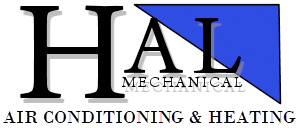AC, or air conditioning, is an essential component of modern homes, offices, and other buildings. It is responsible for maintaining a comfortable indoor temperature and humidity level, making the space livable and conducive to productivity. While there are many different types of AC systems, they all share several common parts that make them work. With this in mind, we at Hal Mechanical would like to take a closer look at these parts and their functions.
Main Components of an AC System
Compressor. The compressor is the heart of an AC system. It is responsible for compressing the refrigerant gas and increasing its temperature and pressure. The hot, high-pressure gas then flows to the condenser, where it is cooled and converted back into a liquid.
Condenser. The condenser is a heat exchanger that is responsible for dissipating the heat absorbed by the refrigerant gas. It is located outside the building and consists of a set of coils and fins that allow air to flow through and carry away the heat. As the hot refrigerant gas flows through the condenser coils, it cools down and condenses into a liquid.
Expansion Valve. The expansion valve is a small device located between the evaporator and condenser coils. Its function is to regulate the flow of refrigerant and control its pressure and temperature. As the high-pressure liquid refrigerant flows through the expansion valve, it expands rapidly, causing a drop in pressure and temperature.
Evaporator. The evaporator is another heat exchanger that is responsible for absorbing heat from the indoor air. It is located inside the building and consists of a set of coils and fins that allow air to flow through and transfer heat to the refrigerant. As the warm indoor air flows over the evaporator coils, it cools down, and the refrigerant inside the coils absorbs the heat and evaporates into a gas.
Fan. The fan is an essential part of an AC system as it circulates the air inside the building and helps to distribute cool air evenly. In most AC systems, there are two fans: one located inside the building that circulates the air over the evaporator coils, and another located outside that blows air over the condenser coils.
Thermostat. The thermostat is a temperature-sensitive switch that controls the operation of the AC system. It is usually located on the wall and allows the user to set the desired indoor temperature. When the temperature inside the building rises above the set point, the thermostat sends a signal to the AC system to turn on, and when the temperature falls below the set point, it sends a signal to turn off.
Ductwork. Ductwork is a network of pipes and channels that distribute cool air throughout the building. It is usually made of metal, fiberglass, or plastic and is hidden behind walls and ceilings. The ductwork is connected to the AC system’s air handler, which blows cool air into the ducts and distributes it to the various rooms in the building.
Central Air Conditioner Services in Aliante, Centennial, Desert Shores, Eldorado, Enterprise, Green Valley Ranch, Henderson, Lone Mountain Village, North LV, Peccole Ranch, Paradise, Silverado Ranch, Spring Valley, Summerlin, Sunrise Manor, Tuscany Village, Whitney, Winchester & Las Vegas Nevada
Air conditioner systems may vary in size, capacity, and complexity, but they all share common parts that make them work. The compressor, condenser, expansion valve, evaporator, fan, thermostat, and ductwork are essential components that work together to provide a comfortable indoor environment. Understanding how these parts work and their functions can help you troubleshoot common AC problems and ensure that your AC system runs efficiently and effectively. When you need AC services in the Las Vegas Valley, call in the experts of Hal Mechanical and let us take care of your cooling system.






